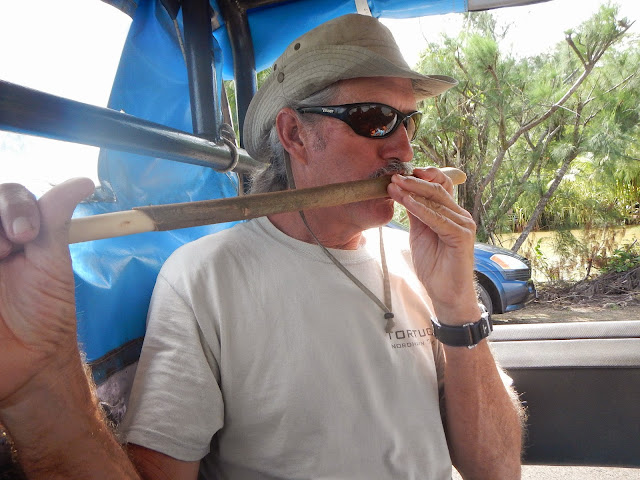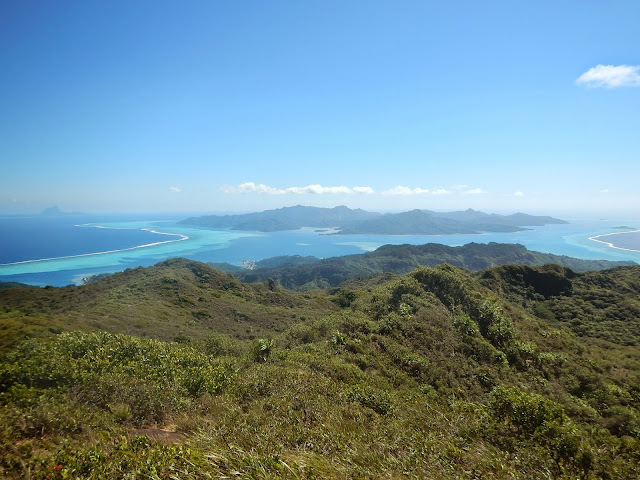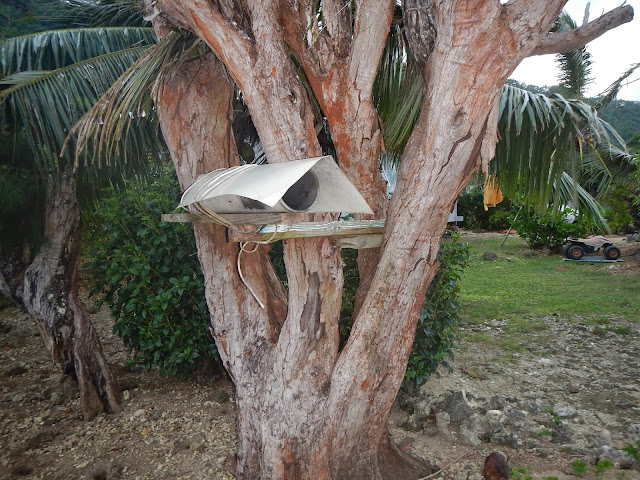There is no shame in not knowing;
The shame lies in not finding out.
Russian Proverb
 |
| Aro, our tour guide, also paddles pirogues - check out the arms! |
Located in the same lagoon are two islands Tahaa and Raiatea. We first visit the northernmost and smallest one, Tahaa or Vanilla Island named such since they produce 80% of French Polynesia's delicious vanilla.
 |
| Church on blue lagoon |
 |
| Blue doorway lost in the jungle growth |
We take a guided tour of the island mainly to visit a pearl
farm and a vanilla plantation. Of course we are given the added bonus of being entertained by a very good local guide, Aro.
We notice homes built on the water around the island. A thing we hadn’t seen yet except for small
pearl farm shacks usually located near their pearl production.
 |
| House on the water - catamaran sailing in the background |
 |
| Making windmill toy out of palm leaves |
 |
| Final product - let the wind take it away |
Also of note are all the tombs in people’s yards. There are no central cemeteries in most of
the Leeward Islands, only family ones.
This will change as we enter the Tuomatus. Churches have tried to centralize tombs but
have been unsuccessful. In general the
churches have the best lands on the lagoon’s edge. Many schools are like that as well. With such beautiful views it would be
difficult to concentrate on schooling it seems….
 |
| Plate made of wild hibiscus leaves - Leaf can also go in Tahitian oven |
 |
| Wrap small chunks of food with leaf - Akin to tamale wrapped with corn husk - Use stem to close |
Aro shows us everything that can be made of wild hibiscus
plant: plates, envelope for cooking or steaming food (akin to tinfoil), cordage,
‘grass-like’ skirt material, and nasal flute as well as a kid’s windmill toy from palm
leaves. He demonstrates how easy (with
the knowhow) it is to open a coconut with another coconut, a fist, or a
stick… Looks a lot easier and painless when
he does it! He also speaks of the miro
(local rosewood) and how its flower can help ease mosquito bite itch and how the
bright yellow sap of the unripe fruit can be used as nail polish. He put some on one of my thumb nails and it
lasted 3 days even with several hand washes and showers…
 |
| Maybe a nasal flute but it can be played by mouth too |
 |
| Nets, buoys, small boat... |
He addresses the two types of roofing we can find around
here, one made of pandanu leaves the other of palm leaves. Pandanu roofs take a lot more work but last
about 8-10 years if maintained and made properly. Palm leaf roofs only last 6 months if made of
green leaves and 5 years if made of dried leaves. Either way the dry plant material is first
soaked in ocean water for a minimum of 12 hours to bug-proof it. Bugs do not like to eat that much salt. It also helps against some types of molds. They are both woven in their own way before
being applied to roofs. They are truly
beautiful and if very thickly installed they look somewhat like European
thatched roofs. There are fewer and
fewer homes using natural roofing (not cost efficient and fire hazards) but the
government dictates that large hotels MUST use these types of roofing on 80% of
their structures. It shows tourists the
local craft and keeps the craft alive.
One of the few times I’m in agreement with a government idea…
 |
| Peeling outer layer of coconut by hand |
He then picks up one of the native land crabs. They dig holes everywhere near the beaches
and roads. In the process they consume a
lot of roots that contain toxic substances.
Being around heavily traveled roads also brings toxicity to their
habitat. The locals, after they catch
them, keep them in a separate bin, feeding them good water and local fruits to
sweeten and detoxify their meat. At
first their back is green-brown, after three weeks of detox and good food, they
turn yellow-green, meaning they are ready to consume. The male has a flat back;
the female has a rounder back. Some of
these crabs become so big that at night their claws can pierce tires. Cars, scooters and bicycles beware and bypass
them when they roam the roads at night…
Pandanu or corkscrew pine has a white flower that smells
like beer. It is called hinano – hence
the local beer name. The flower is not
currently in bloom, only the pinecone-like fruit is on the trees. Interesting to know where the beer name comes
from, no one had explained that to us yet.
 |
| Vanilla beans starting to mature |
 |
| Green vanilla beans - Each plant can grow about 4 kilos |
 |
| Vanilla green house |
 |
| Vanilla bloom (out of season) - Not sure why that plant is blooming now |
 |
| Drying vanilla beans over the next 3 months |
Vanilla plantations are mostly under covers for both shade and
protection from various critters. At
maturity, each plant can grow about 4 kilos of vanilla. For each kilo of fresh vanilla you get ¼ kilo
of dried vanilla. Tahitian vanilla comes
from a merging of Mexico and Madagascar vanilla plants. The main difference is that the other two
vanillas have to be boiled before they can be used. Tahitian vanilla is sundried. As it is dried, it is massaged by hand to
keep a good shape and to even out where the moisture is (they call it sweating
the bean). It takes 9 months (just like
a human baby) to grow a vanilla bean and 3 months to dry it. Vanilla is hand pollinated. It takes a vine 5 years before it starts
producing sufficiently; all in all a very long process.
A 500m2 plantation will produce
about 250 kilo of dried vanilla that can sell for up to $200-300/kilo depending
on quality (or $75,000/year). Many
vanilla farmers only work the vanilla from 4-6am daily then go to their regular
job. Many farmers however don’t want to
be bothered with the 3 months it takes to dry the vanilla and sell it green to
professional driers. They make less but
quicker money that way.
 |
| Too muddy to grow young pearls - Can grow more mature ones |
At the pearl farm it’s the same story about patience and
long term goals as for vanilla. It takes
from 5-7 years to get a good pearl and an oyster can only make 3 pearls in its
lifetime. A new oyster has to be grown
for the next generation of pearls. Oysters
are checked for the size of their gonad, which will determine the size of the
introduced nucleus leading to the final size of the pearl. Most nuclei are made of perfectly round beads
from Mississippi River shells. Oyster
lips will be cut in tiny 3mm pieces to assist with the nucleus’ color. If the piece is reddish, the pearl will be
reddish. If the nucleus gets rejected
and the lip piece gets covered as a would be pearl it becomes what they call a
kechi or irregular pearl of much lower quality but still sold on the
market. Grafted oysters are put into
special net bags so it is easy to see which ones reject their nucleus since it
will be found at the bottom of the bag. The
process has to be started over with these specimens.
Large pearl farms would like to see more regulations,
smaller farms do not. If someone goes to
have their pearls inspected for certification each pearl that doesn’t meet the
standard will be destroyed. Large pearl
farms can withstand such losses; small pearl farmers would still like to be
able to sell these pearls of lesser qualities.
These lesser pearls dilute the already overloaded pearl market. Too many are now produced and the prices are
going down (not currently the best of investment)…
Price of pearls depends on size, luster, color, thickness,
and % of imperfections. AA only has less
than 3% imperfections, A less than 10%, B less than 30%, C less than 60% and
then there is D… It takes about 5 years
to the first pearl, 7 to the third and last one.
I ask our guide about flower necklaces vs. shell or seed
necklaces. He said the flowers are used
to welcome you, say hello while the shell or seed necklaces are used to say
goodbye – they last longer and will remind you of the ones who gave them to
you. We see shell necklaces on tombs –
goodbye to the dead loved ones – it makes sense.
 |
| Mail box to baguette box |
What we thought were mailboxes around the island turn out to
be baguette boxes. Our guide likes to
say only the lazy ones have baguette boxes…
We learn a lot from Aro and appreciate his fun loving
demeanor. What we learn too is that
people who are in 5 star resorts like everyone who is on the tour with us do not
get exposed to the local lore, people, food, etc. They do not get to experience their life as
Polynesians. Many who spoke with us felt
we were lucky to live with them rather than be only served by them. They couldn’t believe how much more we knew
about their culture. They were a little
envious of our way of traveling.
On Tahaa, we, for the first time, tasted tuna paté. It was made of tender white tuna mixed with
bread that had been soaked in white wine.
Shaped into a loaf with herbs then cut into slices of pate to eat with
baguette – Delightful. There is just so
much one can learn to do with fish when that is all there is around…
 |
| Job title: Monkey man... |
We move to Raiatea a short 40 minute boat ride to the south
of Tahaa but in the same lagoon. Raiatea
is larger and more populated, has the airport and the hospital. On the way there we ask the boat captain what
exactly he calls the young man at the back of the boat going back and forth
across the stern. We call him ‘monkey’
just like the motorcycle sidecar monkeys.
He helps stabilize the boat especially when we turn. Never heard of that job before… How would that look on a resume for job
title? Monkey man…
 |
| Mike climbing the three cascades |
 |
| In mape (local chestnut tree) forest |
 |
| Along bamboo forest |
We enjoy a hike up a river next to our pension aptly named
“Three Cascades”. After that we walk to
town but the electricity is out until dinner so most everything is shut
down. As soon as power comes back we
cook a simple dinner and head to bed early.
Tomorrow we hired a guide to take us up river in kayaks and want to be
ready. The next day comes and no guide shows
up; our pension’s owner forgot to confirm.
We end up finding our own kayaks and do the trip ourselves at no
cost. It probably wasn’t as involved as
with a guide but it was still worth it.
 |
| Palm orchid (leaves same shape as baby palm trees) |
The following day we hike to the Te Mehani plateau with
Thiery Laroche our guide for the day. On
the way up we see that the Caribbean pine and the acacia trees have taken over
most of the mountain, outpacing indigenous plants like the pandanus. We want to see an extremely rare flower, the
tiare apetahi, Raiatea’s emblem. On the
plateau we visit, only 28 plants remain.
This plant from the campanula family is extremely rare and nearly impossible
to transplant. The word apetahi (meaning
only one half) grows extremely slowly.
The specimen we are shown are only 2 foot tall and 200 years old. Because it is the emblem of Raiatea, many
locals still sneak-up on the plateau to steal the flower for baptisms,
weddings, visiting relatives, etc. The
plant doesn’t seem to stand a good chance of survival. There is fortunately another much more
difficult to access plateau where it is thought 500 plants live. Only very few scientists with special access
privileges are allowed to go. Although
we had to trek 12 km of very bushy and mountainous terrain to get there we were
very happy to see this gorgeous and unique flower.
 |
| On the plateau looking towards Tahaa and Bora Bora |
 |
| Channel between Tahaa and Raiatea |
Our guide points out that wild cats (from domesticated
population) are starting to come up the plateau indicating the petrel birds are
soon to return to the island to mate and have babies. Somehow the cats know when the season
begins. They try to trap or poison the
cats for the baby petrels don’t have much of a chance to survive their attacks. Amazing how so much of what man brings to
islands (pets, plants, and diseases) creates havoc on indigenous local
species. Somehow the wild cats are not
interested in eating the dense rat population – birds are easier preys.
There are only two native birds left and the
wild cats are making a big dent in their already dwindling numbers: green
pigeon and king fisher. They can only be found in densely forested
narrow valleys where few people meander.
Rats also eat fruits containing seeds that would normally fall on the
ground and produce seedlings. Since
these seeds are now being consumed locals have to gather the fruits and start
new plants in greenhouses before planting – the normal reproductive cycle of
native plants has been altered too drastically to sustain a healthy population.
 |
| Hinano flower the Tahitian beer is named after |
 |
| Fruit from same plants |
 |
| Even on the plateau you find streams, water |
Tidbits:
- We learn that Tahitian language only uses 13 letters: O,E,I,A,U,H,J,M,N,P,R,T, V (although there are some variances between Marquesans, Tahitians, and other islands.
- 45% of Tahitians have diabetes.
- 20% kids are adopted. Many young parents unable to care for them leave them with extended family members. Speaking of kids, the Tahitian word for them is tamari (like the sauce)…
- Pregnant women living on islands where there are no hospitals get to stay in pensions at islands with maternity wards for up to 2 months prior to birth of baby - all expenses paid!
- The majority of men over 45 have gout from too rich a diet.
- Many flights are not full on purpose. They keep some airplanes light due to runways being too short for full loads to land safely, and allow for extra fuel.
- They build eco-friendly hotels but have to blast the coral reefs to pieces to build them???
- Instead of vets flying to smaller islands on a regular basis (i.e.: once a month) they fly sick animals to vets who are in major cities. Can you imagine the cost?
- Scientists from France and Spain have come to study the bee population of the islands. It is considered the healthiest in the world. They are very careful not to import anything that could jeopardize this (no honey, certain fruits and nuts, etc).
 |
| Piece de resistance - Tiare Apetahi |
 |
| Open apetahi and one ready to the following morning |
































No comments:
Post a Comment
We are always happy to hear from you but at times it may take a while to get a reply - all depends if we have access to the internet.